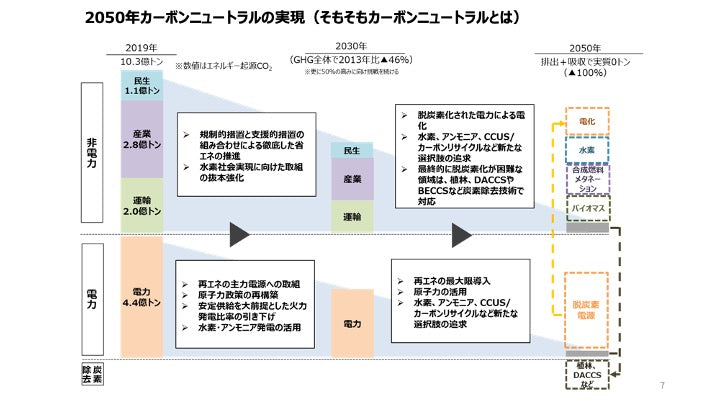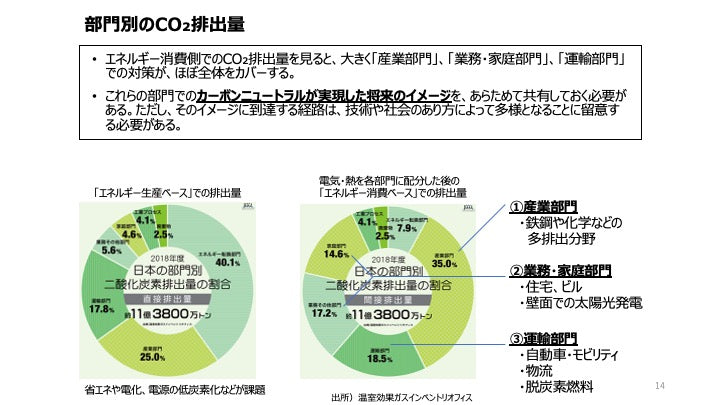Carbon neutral study session report, Part 1: “Why carbon neutral now?”
The term "carbon neutral" has been frequently heard in the news recently. Many of you may be wondering why there are suddenly more opportunities to listen to it.
KAPOK KNOT , which is working on decarbonization as a brand, invited guests to our Ginza showroom " The Crafted " and held a study session to deepen our understanding of "carbon neutrality." This time, we will report on the situation in the first and second parts! In the first part, we will explore initiatives in Japan and the world from the perspective of ``Why is carbon neutral now?''
<Table of contents (first part)>
・Introducing the panelists ・What is carbon neutrality?
・Goals regarding carbon neutrality ・Japan's movement towards carbon neutrality ・Technology to achieve carbon neutrality
Introduction of panelists

This first part focuses on a story from Mr. Minohara of the Ministry of Economy, Trade and Industry. Mr. Minohara works in the department that carries out carbon neutral planning and promotion. Since he was involved in the formulation of a national strategy called the "Green Growth Strategy," he mainly talked about "what is carbon neutrality in the first place" and "the movement towards carbon neutrality in the world / Japan."
What exactly is carbon neutral?
(Minohara) Carboneutral is an initiative to reduce CO2 emissions to virtually zero. The reason we say "real" is because it is impossible to completely reduce emissions to zero. We aim to reduce waste to zero as much as possible, and then collect as much of what is unavoidably emitted as possible. In this way, we aim to reduce the total amount to virtually zero.

Minohara) Currently, electricity is the major source of CO2 emissions. Of course, thermal power generation, which is the most commonly used type of power generation, emits CO2 , so we will change to methods that do not emit CO2 , such as renewable energy and nuclear power generation. It is also possible to use fuels that do not emit CO2 , such as hydrogen or ammonia, for thermal power generation.
The next largest sector is the industrial sector, followed by the transport sector. We will try to reduce the amount of carbon dioxide as much as possible by using decarbonized electricity and using electric or hydrogen vehicles for transportation, but when we consider the positive and negative aspects of CO2 recovery, we can use CO2 recovery technology such as tree planting to reduce the amount of CO2 that is inevitably produced. We will reduce CO2 to zero.
Fukai: Does this mean that there will be a movement to reduce what is currently being emitted and a movement to collect it?
Minohara) That's right. Various efforts are already underway regarding collection technologies. CO2 and hydrogen can be combined to produce methane as fuel, or alcohol can be made into a chemical product. Since CO2 only becomes harmful when it is released into the air as a gas, it must be made solid or liquid to prevent it from producing a greenhouse effect. There are also cases of burying it underground, and a demonstration experiment in Tomakomai has been successful, but the cost is still high. The future challenges are how to lower the price and efficiently find suitable land to fill.
Carbon neutrality goals

(Minohara) The red regions are countries that have announced that they will achieve carbon neutrality by 2050 . China has announced that it will achieve this by 2060 .
So why is carbon neutrality accelerating recently? Originally, it was thought that new investments and human resource development were necessary to achieve carbon neutrality, but recently, the mindset has changed, and many countries are now starting to believe that taking measures to combat global warming will be the driving force behind growth. That's because.
The EU is at the extreme. We are working on the concept of green recovery, which aims to restore growth that has fallen due to the coronavirus pandemic through environmental policy initiatives. For example, there is a taxonomy that classifies all products and services as either ``green'' or ``non-green,'' and ensures that money only goes to initiatives that are judged to be green. As a result, Toyota's hybrid cars, which sell worldwide, are judged to be ``not green'' because they do not completely emit CO2 . In contrast, EU car manufacturers have adopted a strategy of investing fully in electric and hydrogen vehicles to grow the industry.
Fukai: Speaking of global warming countermeasures, the first thing I learned about when I was a student was the Kyoto Protocol...how is that updated?
Minohara: The Kyoto Protocol is only imposed on developed countries, and countries such as the United States and China have withdrawn from it, so its effectiveness is weak. In fact, developing countries account for a significant amount of CO2 emissions. On the other hand, the Paris Agreement, adopted in 2015 , requires all signatory countries to achieve their goals.

Minohara) Unlike the Kyoto Protocol, which was an obligation, the Paris Agreement is a bit looser because it is an obligation to make efforts, but as the trend toward decarbonization is accelerating worldwide, it is important to realize decarbonization throughout the world. That is the Paris Agreement.
Japan's move towards carbon neutrality
(Minohara) Last October , Prime Minister Suga declared Japan to be carbon neutral by 2050 in his policy speech. The strategy to achieve this goal is the "Green Growth Strategy."
The reason why it is a growth strategy is because, like the EU , Japan's industry is growing by working toward carbon neutrality. We have selected 14 priority fields that will grow toward 2050 , such as energy, industry, and housing, and will do our best to support efforts by private companies, universities, etc. in these fields.
For example, in the field of automobiles and storage batteries, 100% of new car sales will be electric vehicles in 2035 . For automakers, converting to electric vehicles may require new investments or cause them to lose the technology they currently have. Gas stations and suppliers that make auto parts will also be hit hard. Since a major change in the industrial structure will be necessary in the first place, this strategy is about coming up with policies that the country can implement, such as taxation and finance.
Fukai) I see. Amidst these trends as a country, Mr. Murakami, as a retailer, do you feel that environmentally friendly products are selling well in Japan?
Murakami: Based on a survey of EPOS card members, it seems that about 80 % of them are interested in the environment. On the other hand, many people say that they are unable to take action because they do not know where to start. I would like to create a situation where it is easy for people to participate in purchasing products that are good for the environment, thinking they are cute, and finding them good for the environment.
Technology to achieve carbon neutrality

Minohara) As I mentioned earlier, the area with the highest amount of CO2 emissions is the part used for ``electricity/energy conversion.'' Next comes the industrial sector and then the transport sector.
As an example, I would like to introduce an image of decarbonization in the transportation sector. Earlier, there was talk of 100% electric vehicles by 2035 , but these electric vehicles include not only zero CO2 emitting vehicles such as electric cars and hydrogen cars, but also vehicles that use a little gasoline, such as hybrid cars and plug-in hybrid cars. Also included. However, recently, technological development of gasoline ( e-fuel ) that uses CO2 as a raw material has progressed, and there is a movement towards achieving carbon neutrality overall by reusing emitted CO2 .
In addition, when using an electric car, even if the car itself does not emit CO2 , if the electricity is generated using a power generation method that emits CO2 , it will not be decarbonized from the perspective of the entire life cycle, so decarbonization of renewable energy, nuclear power, etc. There is also a movement to use the generated electricity.
From a transportation perspective, we are currently researching and developing hydrogen-powered airplanes and ammonia-powered ships.
Fukai) Kapok Knot also recently calculated CO2 emissions using open source, and the emissions from transportation were quite large. So, if we can achieve decarbonization in the transportation sector, I think we can also achieve decarbonization as a brand!
Minohara) That's right. I think the decarbonization of transportation will have a large impact on other industries. There is another technology that I would like to introduce to you: ``Negative Emission Technology''.

DAC ( Direct Air Capture ) is a technology that captures concentrated CO2 produced by thermal power generation directly from the atmosphere. Technological developments are underway to combine the captured CO2 with hydrogen to create a synthetic fuel, store it underground, and use it in plants to grow plants and carbonated drinks.
Fukai: It's interesting that something negative has the potential to turn into something positive!
Minohara) That's right. Although not related to technology, a policy called ``carbon pricing'' is also progressing.

(Minohara) As the name suggests, it is a policy that puts a price on carbon.For example, a ``carbon tax'' is a system in which a tax is levied according to the amount of CO2 emissions. Japan has already begun collecting money as a ``global warming countermeasure tax''. However, since the rates differ between countries, "carbon border adjustment measures" were devised to make them equal. Anticipating the idea that ``if the price of CO2 in your country is high, you should just make it in a cheap country and import it,'' a system is being considered that would impose higher tariffs when importing from a cheap country to a high-priced country.
(Minohara) However, if the carbon tax is set too high, it could weaken companies' efforts to reduce CO2 emissions and have the opposite effect, so it is still under discussion in Japan. Some direction is expected to be provided this summer.
Fukai) I see. If a carbon tax is applied to KAPOK KNOT's business, it may become possible in the future that environmentally friendly materials will be cheaper than ordinary materials, for example!
* * * * *
Why is carbon neutral now? We hope that you have gained a deeper understanding of how the world is moving towards carbon neutrality.
In the second part, Mr. Murakami from MARUI GROUP's Sustainability Department will introduce the company's specific initiatives.
*Click here for the second part

Leave a comment
This site is protected by hCaptcha and the hCaptcha Privacy Policy and Terms of Service apply.